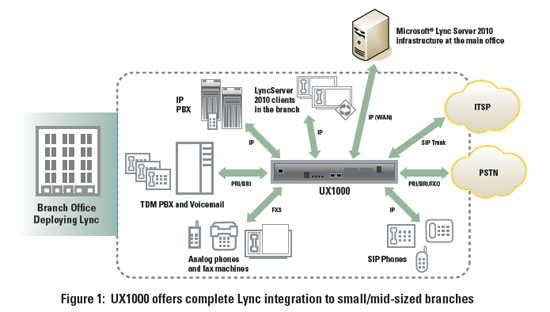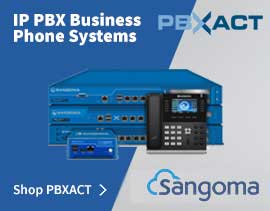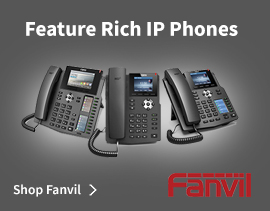NET UX1000 SBC Lync Gateway with 6 UX-SIP-5 licenses - upto 30 IP Calls - QUX1K-SBC-30
NET UX1000 SBC Lync Gateway with 6 UX-SIP-5 licenses All-in-One Survivable Branch Appliance (SBA) ensures that Microsoft Lync Server will operate at a high level of security and quality in branch offices during wide area network failures. The NET UX1000 SBC Lync Gateway QUX1K-SBC-30 enables upto 30 IP Calls but can also extended to a maximum of 60 IP Calls.

The NET UX1000 SBC is a Microsoft Lync compatible gateway.
Offers cost effective and comprehensive Microsoft® Lync™ enhanced gateway/SBA (Survivable Branch Appliance) deployment services for small to mid-size branch offices. Maximizes Lync integration given extensive I/O, "any to any" switching with full security, and enterprise SBC.
UX1000 QUX1K-SBC-30 Session Mediation Platform, the latest product based on the company's UX Series high performance platform extends the range of the UX Branch Office solutions for Microsoft Lync. Ideal for enterprises of all sizes, the UX Series family of products easily and securely connects branch office employees to headquarters-based unified communications (UC) systems. NET's UX1000 gives midsize businesses access to "enterprise grade" UC with integrated collaboration capabilities without taxing IT and financial resources.
UX1000 QUX1K-SBC-30 Benefits:
- Simplifies Lync deployments via easy to use, single comprehensive web UI for gateway and SBA management
- Secures the SBA application from network attacks through the highly integrated and secure appliance platform
- SRTP (secured VoIP media) and TLS (secured VoIP signaling) are fully supported with no impact on call capacity.
The NET UX1000 SBC with 3 UX-SIP-5 licenses offers true "any-to-any" signaling translation and media interworking between Lync and legacy analog, TDM clients and PSTN endpoints. The UX1000 can simultaneously connect to legacy TDM PBXs and the PSTN through 2 T1/E1 PRI ports. Alongside the PRI ports, up to 24 FXS/FXO ports are available for analog phones, faxes, and the PSTN. BRI ports are also supported, and may exist alongside the FXS, FXO, and PRI ports to provide complete analog/TDM device integration into a branch office's Lync topology.

In parallel, the NET UX1000 SBC Lync Gateway with 6 UX-SIP-5 licensess also interconnects IP-based endpoints (i.e. IP PBXs, non-Lync SIP clients) and public VoIP networks (e.g. ITSPs) to the Lync clients. And, with NET's optional SmartSIP application, there's no need to replace your legacy non-Lync SIP clients; the UX1000 can report non-Lync SIP client user states (e.g. presence, user busy, etc.) to Lync clients.
The UX1000 Session Border Controller with 6 UX-SIP-5 licenses offers a wide range of I/O and call capacities (4 to 84 concurrent PSTN/analog VoIP connections) to optimize branch office enhanced gateway/SBA costs. Simultaneously, the NET UX1000 SBC with 6 UX-SIP-5 licenses can support up to 45 IP to IP calls. SRTP (secured VoIP media) and TLS (secured VoIP signaling) are fully supported with no impact on call capacity. Voice media quality is enhanced, given the latest generation embedded IP switching fabric at the core of the UX1000 system. And, to help with Lync migration in the branch, the UX1000 provides advanced call routing features such as Active Directory/LDAP server routing integration, on-board call forking ("forks" a single call from any source to 8 unique destinations), and other flexible routing options.
Intergrated Enterprise SBC Offers Optimised SIP Trunking For Lync
With an integrated enterprise SBC (Session Border Controller), the NET UX1000 QUX1K-SBC-30 offers to branch Lync users optimised SIP Trunking services for ITSP (Internet Telephony Service Provider) connectivity.
- Complete enterprise/ ITSP demarcation point services, such as network
topology hiding, transcoding, IP transport conversion (TCP <-> UDP),
and signaling/media encryption (TCP<->TLS/RTP <->SRTP)
- Multi-ITSP registration, with re-routing on excess cost or loss of servic
- Built-in NAT1 (Network Address Translation), prevention of DDOS and
DOS (Denial of Service) attacks, and CAC (Call Admission Control) to
prevent unauthorized access and to maintain secure communications.
Technical Specifications
External Interfaces
- Digital and Analog Modules
• Up to 2 T1/E1 CAS (Channel Associated Signaling)/PRI (Primary RateInterface) digital voice/TDM port
• Up to 8 BRI (Basic Rate Interface) digital voice/TDM ports
• Up to 24 FXS (Foreign eXchange Station) analog ports
• Up to 24 globally compliant FXO (Foreign eXchange Office) analog ports
Ethernet Interfaces
- WAN and LAN Interfaces
• 2 10/100/1000 BASE-T (software configurable for WAN and LAN interfaces)
• Auto-MDIX
• Both are routable up to 100 Mbps full duplex
Applications Solutions Module (ASM) Option for SBA Deployments into Small/Medium (25+ Users) Branch Offices
- CPU Intel® Celeron™ P4505 @1.8GHz
- Memory 4 GB DDR3 with ECC
Applications Solutions Module (ASM) Option for SBA Deployments into Small (Less Than 25 Users) Branch Offices
- CPU Intel® Atom™ D525 processor
- Memory 2 GB DDR3 (non ECC)
Call Processing
- Any-to-Any Signaling
• SIP (UDP/TCP/TLS) <-> SIP (UDP/TCP/TLS)
• SIP (UDP/TCP/TLS) <-> CAS/PRI/BRI/FXS/FXO
• CAS/PRI/BRI/FXS/FXO <-> CAS/PRI/BRI/FXS/FXO
- Any-to-Any Switching
• RTP/SRTP<-> RTP/SRTP
• RTP/SRTP<-> TDM/analog
• TDM/analog <-> TDM/analog
- Call Routing
• Active Directory/LDAP based call routing
• Routing based on quality metrics and least costs
• On-board Call Forking (up to 8 endpoints)
- Supplementary Services
• Call hold, Call Transfer – Blind and Assisted, Call Forward
Signaling and TDM-VoIP Call Capacity
- TDM Signaling
• ISDN: AT&T 4ESS, AT&T 5ESS, Nortel DMS100, Euro ISDN (ETSI
300102), QSIG, NTT InsNet (Japan), and ANSI National ISDN-2 (NI-2)
• CAS: T1 CAS (E&M, Loop start), E1 CAS (R2)
- TDM-VoIP Call Capacity
• Up to 84 calls; adequate capacity for a 400 seat office
Enterprise SBC Functions for Enhanced SIP Trunking
- IP to IP Call Capacity Up to 45 sessions, with 600 registered users
- DHCP Server and client
- Security
• Denial of service protection
• Encryption (TLS, SRTP, HTTPS, SSH)
• Authentication (User name/password; Active Directory; RADIUS)
• Topology hiding, User Privacy
• Traffic separation1 (VLAN interface separation)
• DNIS, CLID, Call type pre-authentication
- Interoperability • Large number of TDM PBXs, IP-PBXs
• Qualified for Microsoft Lync
• Certified with large number of SIP Trunking service providers
- Transcoding • SIP Over UDP; SIP over TCP; SIP over TLS; RTP; SRTP
• Codecs (G.711 A-law/Mu-law; G.723; G.729)
• Signal conversion (DTMF/RFC2833; Inband DTMF)
- NAT Symmetric NAT, UX1000 node behind NAT
- SIP Header Manipulation
• Digit manipulation (name/number manipulation using regular expression and Active Directory lookup)
- Quality of Service and Service Assurance
• Call Admission Control (deny excessive calls based on session establishment rate per trunk group)
• P-time mediation for rate limiting
- Survivability
• Bypass relays (PRI<-> PRI, FXS<->FXO) for emergency calls like 911
• PSTN fallback (when WAN is down)
• Survivable Branch Appliance for Microsoft Lync
• Multiple SIP Trunking service provider support for redundancy
- SIP Routing
• Based on Source and destination IP Address
• Fully Qualified Domain Name (FQDN)
- High Availability and Load balancing
• Detects Proxy failure and route to alternate paths
• Re-route on failure based on full Cause Code rerouting on T1/E1 trunks
Management
- OA&M
• Single, secure Web GUI to manage UX1000 and SBA
• REST based programmatic interface to manage multiple UX1000
devices from a remote site
• SNMP v1/v2/v2c for comprehensive network management using third
party network management systems
• RADIUS Authentication and Accounting
• Image backup and restore/Configuration upload from one site to another












